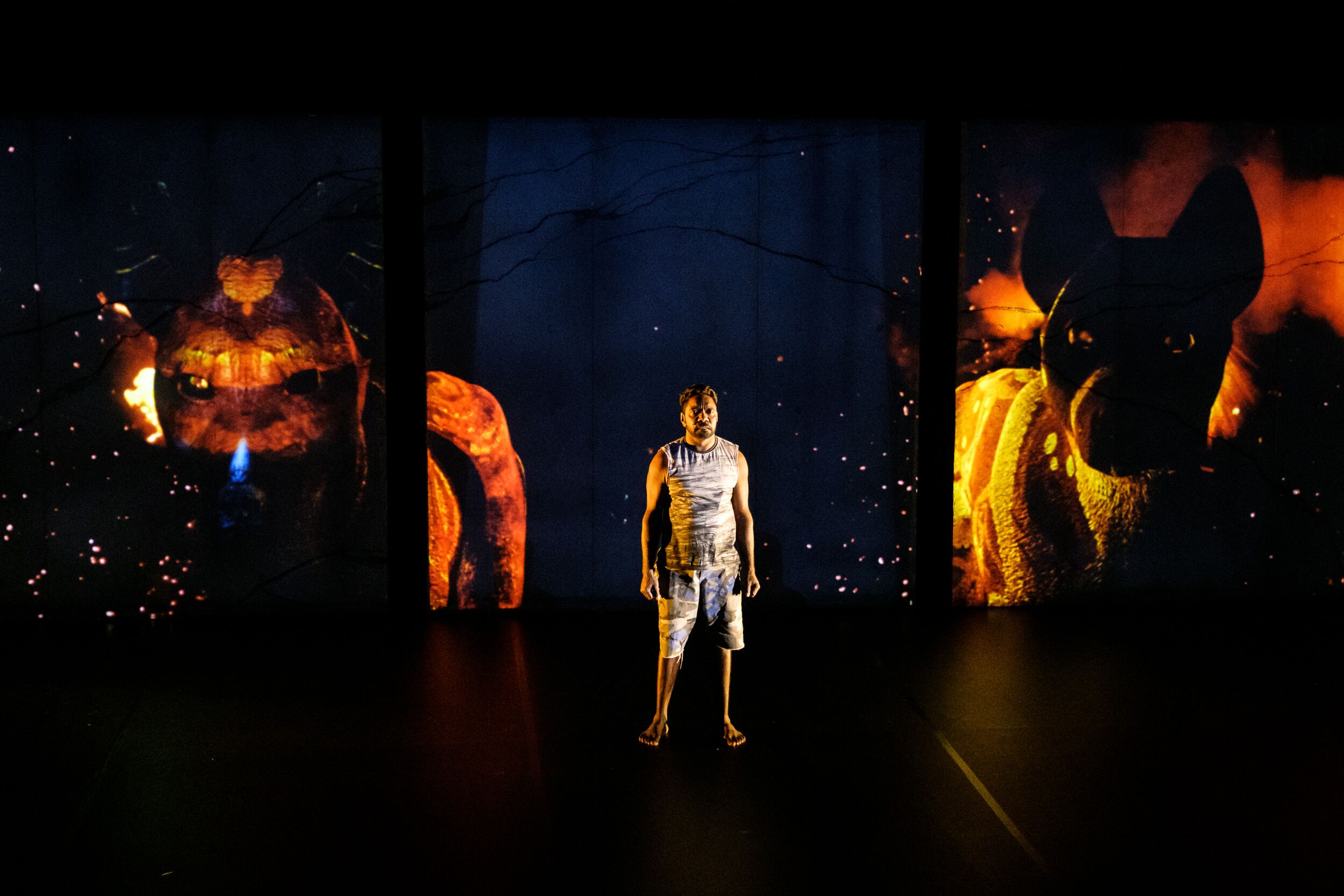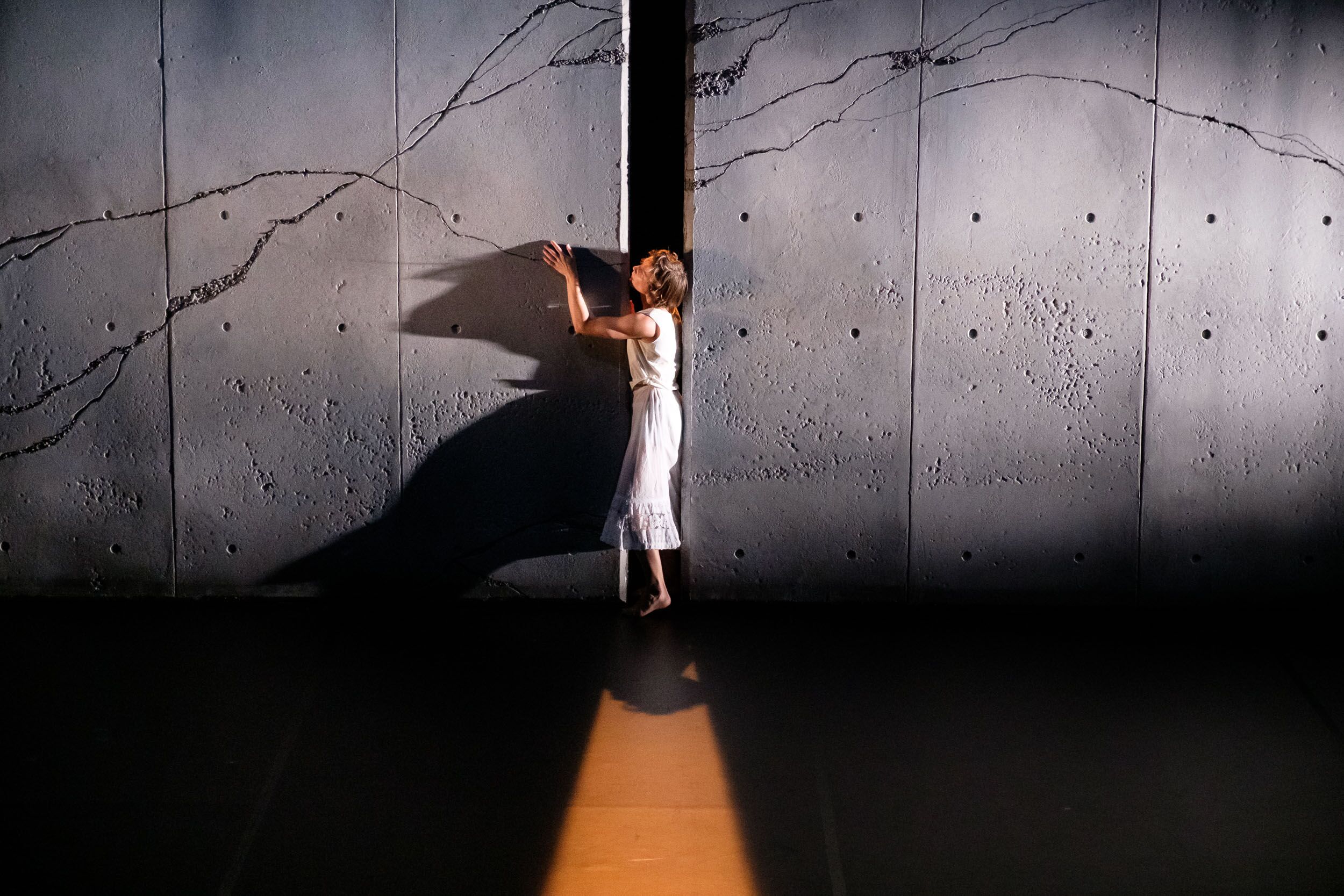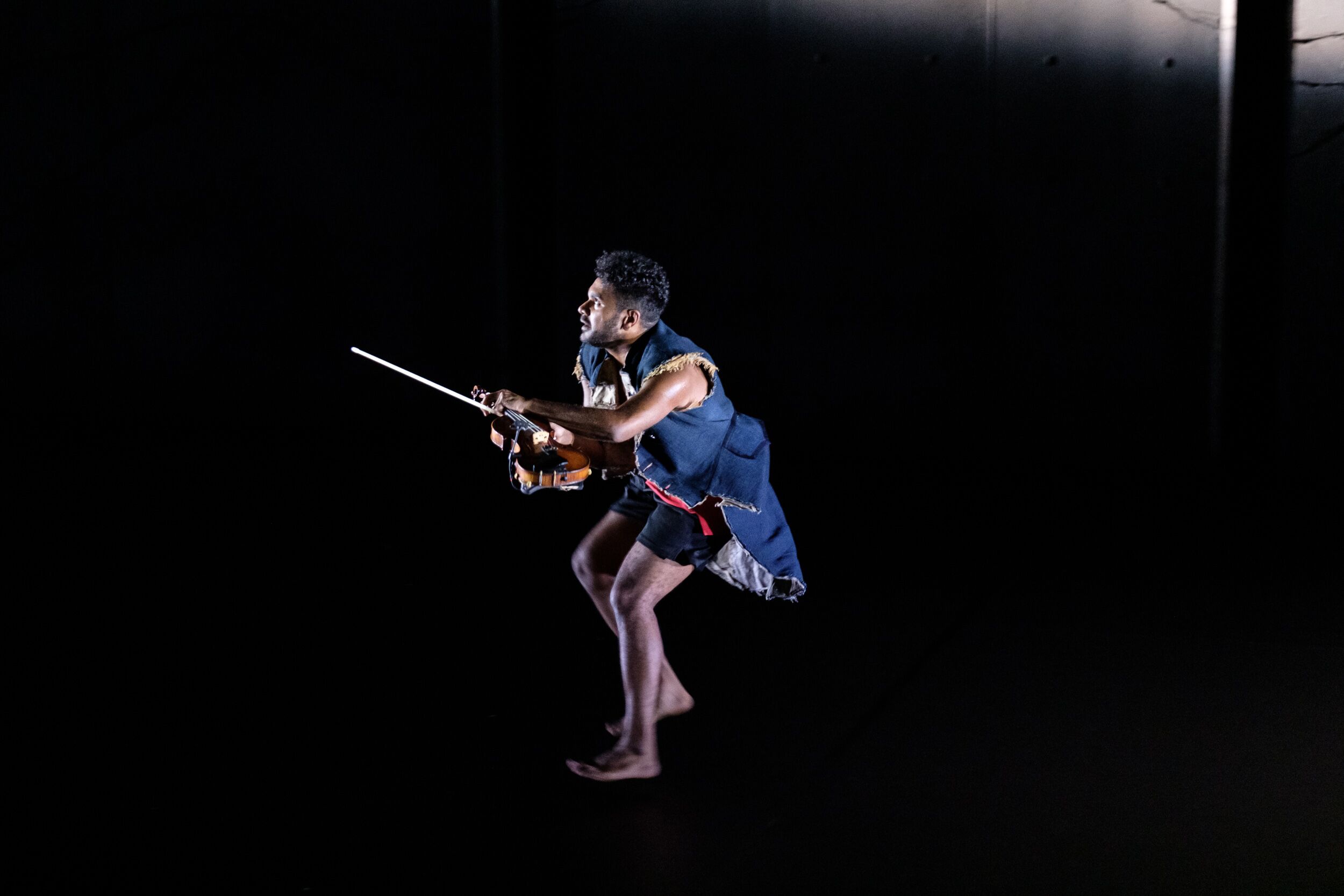Marrugeku 'Dancing Forwards'

Edwin Lee Mulligan is dominated by the masked figures of Yungngora and Jirribil, the dingo twins that loom large in Nyikina mythology
Posted by Jeremy Eccles | 31.05.19
Dates:
30.05.19
: 01.06.19
Location: Carriageworks, Wilson Street, Eveleigh, Sydney
The Marrugeku Company has an interesting history. It grew from the non-Indigenous Stalker Company which discovered the First Nations through the innovative work, 'Mimi' – the spirits of Arnhemland wielding their wickedness on stilts! Later co-Artistic Director Rachael Swain bonded with Broome's Dalisa Pigram – not only a great dancer and sensitive Yawuru/Bardi storyteller but increasingly a choreographer and producer of intercultural work. Sadly, Pigram doesn't appear in this latest show at Carriageworks, for Marrugeku has taken on the nurturing role of bringing three solo dance works to fruition – two Aboriginal and one firmly in White Australia's mythological library.
Taken in order of presentation, Edwin Lee Mulligan, aka Warrda Lumbadij Bundajarrdi's work 'Ngarlimbah' is a Nyikina morality that does Mulligan's grandfather, the pioneering painter Jimmy Pike proud. With the assistance of Sohan Haye's imagistic video work, we learn about the two dingoes who are the cultural forebears to Nyikina existence on the desert fringes of the Central Kimberley – one calm, one dark and dangerous. Their chase of an ancestor figure caused him to hurl an axe back at the dogs – causing a flow of blood which, transformed, has supplied the vital red ochre for ceremony ever since.
That dog's final resting place – in the same way that many a Rainbow Serpent lives on below a water source that is also the source of new life in the form of babies' spirits – is a waterlily festooned billabong near Noonkanbah. Mulligan introduces us to much myth about the seeming fragility of the lilies but their actual resilience in the face of fish attack from below and stresses from the winds above.
Humans can learn much from the waterlily – including the title of the piece, which translates as “You are as much part of me as I am of you” - a fundamental Nyikina concept. Did the dance match the words – many spoken or sung in language – explaining these complex beliefs? Probably not. But Mulligan calls himself a poet and a painter, so perhaps he was only operating in his third talent field.
Miranda Wheen is definitely a dancer, leaving the words in this case to the great Kris McQuaid to introduce us to the last, missing chapter of Joan Lindsay's marvellous mystery, 'Picnic at Hanging Rock'. Miranda Wheen, of course, is the lost Miranda of that book, film and TV series.
Here Stephen Curtis's all-purpose set of three, scarred blocks of concrete – a screen for Mulligan, but now the mighty rocks on the summit of Hanging Rock, between which Miranda can slip and disappear – then reappear. Clearly, this Miranda is a frightened lass, running back and forth, falling irrationally, shrinking and unbalancing to the busy electronic score in a manner that brought back memories of the way that the lost-to-Europe Ros Crisp first introduced us to the dark side of Omeo.
Her reappearance, though comes with a new rhythmic positivity, a calm and a much lighter style of dancing. But, at this point Wheen lost me. Perhaps the Marrageku connection bore into her, for she suddenly added an Aboriginal acknowledgement of Country – appropriately tearful at first, but becoming coarsely bogan, with the First People gaining a Second then a Third People as she lamely suggested “We're all special”. This probably wasn't the time and place to suggest that.
For this is Reconciliation Week, which began so well with 'Churaki' at the Opera House, and ended pretty well with Eric Avery's 'Dancing with Strangers'. Avery was looking out from the summit of Gulaga as his ancestor Jack Biamanga called it in 1770 as Captain Cook sailed past and thought he saw a dromedary in the shape of that sacred Yuin hill. Avery's piece attempts to imagine both sides of an unknown story – what Biamanga and Cook might have thought of each other.
Avery has the advantage of a violin that he plays well and electronics that can turn his notes into a symphony – even when it seems to take on a life of its own - as Cook's descendants have tended to do. A wonderfully simple two-way jacket turns Avery's tribal skin cloak into a blue military uniform in which he can mimic Kim Scott's 'Dead Man Dance' – the stiff movements of the military body as paraded by men who must be dead because they reveal no Aboriginal spirituality. The violin becomes a weapon, its bow slashing the air as a sword, but this irrationality is matched by the calm of Avery's Ngiyampaa songmanship – a much more mellifluous sound than Mulligan's desert harshness. We get ancestral Ngiyampaa song too from the invaluable archives. Avery ends with a defiant statement in language.
All works were warmly received on opening night by the audience. I suspect those at the following performances might appreciate a a greater degree of dramaturgy in telling these engaging stories.
URL: https://carriageworks.com.au/events/burrbgaja-yalirra-2019/
Share this:
»  del.icio.us
»
del.icio.us
»  Digg it
»
Digg it
»  reddit
»
reddit
»  Google
»
Google
»  StumbleUpon
»
StumbleUpon
»  Technorati
»
Technorati
»  Facebook
Facebook
Contact Details

Miranda Wheen slips between the mighty blocks at Hanging Rock

Eric Avery's all purpose violin is weaponised in his 'Dancing with Strangers'
Further Research
Artists: Jimmy Pike
News Tags: Carriageworks | Dalisa Pigram | Edwin Lee Mulligan | Eric Avery | Jeremy Eccles | Marrugeku | Miranda Wheen | Rachael Swain
News Categories: Blog | Event | News | Other Event
Exhibition Archive
- 05.06.19 | NY is the Epicentre
- 30.05.19 | Namatjira Wins the Ramsey
- 20.05.19 | The Gagosian Effect
- 13.05.19 | INTERESTING TIMES
- 03.05.19 | GAGOSIAN OPENING TONIGHT
- 02.05.19 | WHO'LL WIN THE WYNNE IN 2019?
- 01.05.19 | Telstra NATSIAA finalists announced
- 14.04.19 | Gagosian Goes Aboriginal
- 10.04.19 | An Indigenous Biennale?
- 30.03.19 | Kunmanara Williams Stars at The National
- 27.03.19 | Parrtjima and CIAF announce 2019 plans
- 19.03.19 | Jarinyanu David Downs Collection Heads to NT
- 14.03.19 | TJUNGUNGUTJA TO ALICE
- 26.02.19 | THE WEST
- 22.02.19 | DICK ROUGHSEY IS TOPS
Advertising

